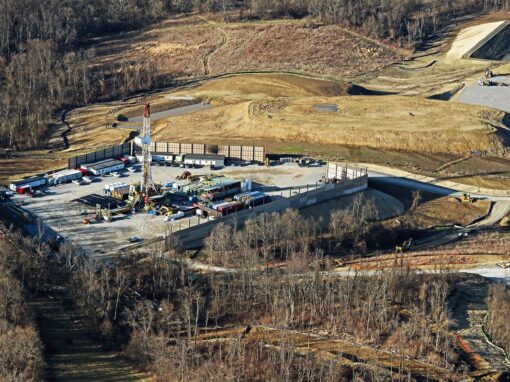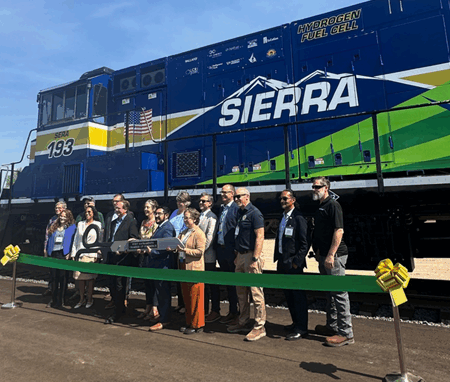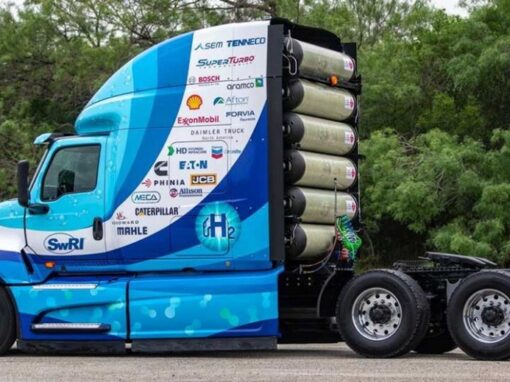With the Federal Transit Administration (FTA) announcing the latest award winners for the FY23 Grants for Buses and Bus Facilities and Low- and No-Emission (Low-No) Vehicle programs – including over $100 million for projects that included Fuel Cell Electric Buses (FCEBs) and hydrogen fueling infrastructure– we thought it would be a good time to explore the recent developments in FCEB deployment and highlight the forward-thinking transit agencies and innovative manufacturers driving this transformation.
As part of the first wave of clean hydrogen adoption identified in the U.S. Clean Hydrogen Strategy and Roadmap, fuel cell electric buses (FCEBs) will play an important role in decarbonizing the larger transportation sector. Across the United States, transit agencies have long recognized and experienced the environmental and economic benefits of FCEBs. Compared with traditional diesel buses, FCEBs emit zero carbon emissions and have higher levels of fuel efficiency. FCEBs also fuel faster, drive longer, and perform better in extreme weather compared to their battery-electric counterparts. According to a recent study commissioned by Foothill Transit that compared the cost of battery electric buses (BEB) versus FCEBs on its 486 Line over a 12-year lifecycle, the cost of operating FCEBs was found to be $12.9 million less than operating BEBs.
In the recent FTA Low/No awards, six transit agencies were awarded funding to purchase FCEBs and related infrastructure. California alone received funding across three transit districts. This included the Alameda-Contra Costa Transit District (AC Transit), which received over $25 million to buy FCEBs to add to its existing FCEB fleet and to retrofit its training and education center to transition to a combined bus maintenance facility and a classroom/laboratory. Funding was also awarded to the Santa Cruz Metropolitan Transit District (METRO), which received more than $20 million to buy FCEBs to replace older diesel buses, build a hydrogen fueling station, make facility upgrades to accommodate the new buses, and develop a workforce training plan. And over $29 million was awarded to the North County Transit District (NCTD) in Northern San Diego County to buy FCEBs to replace older buses and to develop a workforce development program in partnership with a local college.
Moving east, the Regional Transportation Commission of Washoe County in Nevada received almost $9 million to buy FCEBs to replace hybrid diesel buses, install hydrogen fueling infrastructure supplied by FCHEA member Air Products, and create a workforce development program. In Indiana, the Greater Lafayette Public Transportation Corporation received $7.5 million to buy FCEBs and compressed natural gas buses to replace older buses that have exceeded their useful life, modify its maintenance facility to safely maintain vehicles as the fleet expands, as well as install a hydrogen refueling station. Finally, the Delaware Transit Corporation received almost $9 million to buy battery-electric and FCEBs to replace older diesel buses.
The state of California is home to early pioneers in FCEB adoption, including SunLine Transit in the Coachella Valley, AC Transit in the Bay Area, and Foothill Transit in the San Gabriel and Pomona Valleys. In 2003, SunLine Transit was the first transit agency in the world to put a hydrogen fuel cell bus into service, laying the foundation for a long history of fuel cell innovation. Last year, it announced the groundbreaking of construction with Southern California Gas Company for an advanced hydrogen generation system at SunLine’s facility in Thousand Palms, California. SunLine also possesses the largest clean hydrogen-producing station in the country for transportation with its PEM hydrogen electrolyzer and powers its fleets using FCHEA member Ballard Power Systems’ fuel cell power modules.
Foothill Transit recently launched Los Angeles County’s first three FCEBs into revenue service, with a hydrogen refueling station to support the buses from FCHEA member Clean Energy. The Xcelsior CHARGE H2 buses were manufactured by New Flyer, with FCHEA member Ballard Power Systems providing the fuel cell power module and FCHEA member Hexagon Purus providing the hydrogen cylinders, which it manufactures at its facility in Maryland.

Foothill Transit Fuel Cell Electric Bus (Source: Foothill Transit)
In Ohio, the Stark Area Regional Transit Authority (SARTA) operates 15 traditional 40-foot FCEBs and five smaller para-transit vehicles, making it the largest FCEB fleet outside of California. And in Illinois, the Champaign-Urbana Mass Transit District (MTD) produces hydrogen on-site using FCHEA member PDC Machine’s SimpleFuel hydrogen fueling station and FCHEA member Nel’s electrolyzer to power its fleet of FCEBs. MTD also leveraged FCHEA member BayoTech’s temporary fueling station and trailers to provide immediate power to complete a 40-hour drive test before the permanent hydrogen station was ready.
FCEBs have gained significant momentum beyond the United States, with numerous countries embracing this technology as a sustainable alternative to traditional fossil fuel-powered buses. Seoul, South Korea, recently made headlines by announcing plans to replace a total of 1,300 existing buses with FCEBs from FCHEA member Hyundai by 2026. The city will replace 1,000 city and commuter buses as well as 300 airport buses. In Poland, FCHEA member Loop Energy recently announced it will provide Polish electric bus manufacturer ARP E-Vehicles with its T605 fuel cell system. Poland is the largest European producer of electric buses in Europe. And in England, FCHEA member Air Products worked with Transport for London to support the city’s FCEB fleet with the supply and production of hydrogen fuel as well as a dedicated fueling station for five FCEBs.

Hyundai ELEC City Fuel Cell Electric Bus (Source: Hyundai)
As more transit agencies look to abate emissions from their diesel fleets with low and no-emission alternatives, fuel cell electric buses have emerged as a viable path forward. However, it’s important that fuel cell electric buses and battery-electric buses are not viewed as either/or, but rather that transit agencies recognize the unique value each can bring on a case-by-case basis. FCHEA looks forward to supporting our members as they work to build out a zero-emissions transit future with FCEBs.



